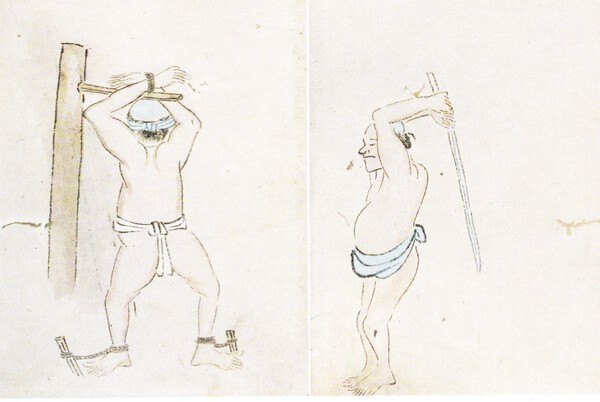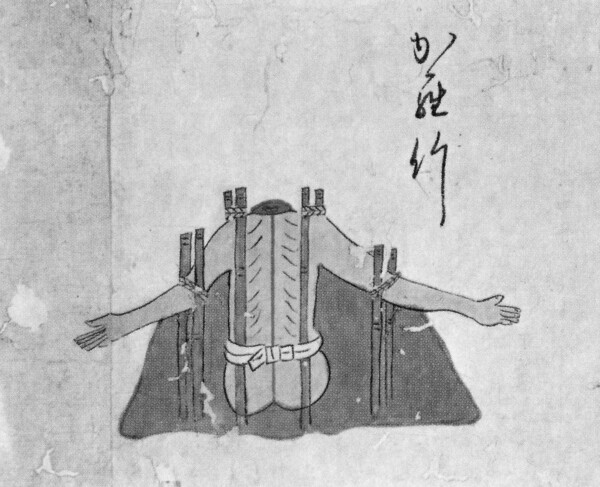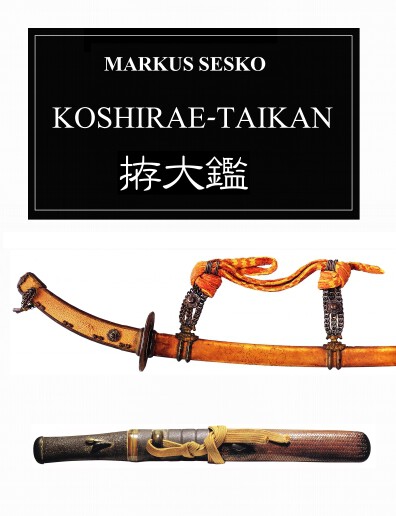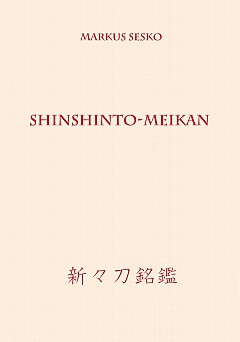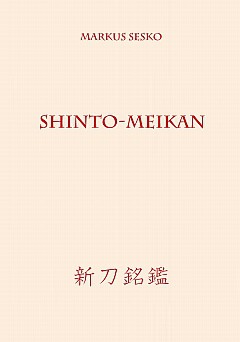-
Posts
949 -
Joined
-
Last visited
-
Days Won
25
Content Type
Profiles
Forums
Events
Store
Downloads
Gallery
Everything posted by Markus
-
@Chris: Thanks for your offer. I will surely have the one or other question when the time comes. Also your project will greatly contribute to the topic and close all those gaps I will leave open on the Tokyo-based smiths. @Brian + George: My aim is to cover all smiths from when the Gendai era starts, i.e. around the ban on swords, to shortly after WWII, so to speak until those smiths who passed on their craft to the "new generation of swordsmiths" whose works we classify today as shinsakuto. What I dont want to do is to present a brief list of smiths with oshigata and tangs. I want to make this as complete as possible, working-in all smiths I can get "my hands on," all biographical data I can find, and all those extra little plusses like Token-Bijutsu articles on certain smiths which add additional insights (provided that I get the permission to [re]publish them). In this sense, I started my appeal way in advance so that the Gendaito Project makes the round and people participate in providing reference material. What I dont want is that someone approaches me after the book is released and says that he was following the project with great interest and that he has a bunch of data in his archive concerning this and that smith which would have been great in the book. @Brian + Stephen: I think this is betting big. So probably 450+ pages, US letter format, hardcover. Just to throw out a number, I think the finished book will be somewhere around 120 USD. I would like to expand on your idea Brian and bring into play the NMB as "drop-in center" and "patron" of this project. My suggestion is, if you agree Brian, to run a poll let´s say for how many are willing and committed to pay 50 USD in advance to get then the finished book for 100. All "normal buyers" have to pay later the 120 USD. I don´t want to ask for more than that and if maybe less than 30 are participating in the poll anyway, we drop the pre-order option and I will still pursue the project of course, but then there will be no whatsoever discount. As mentioned, would be great if the realization or rather completeness of this project is due to the support of the members of the NMB!
-
Hi everyone, I made an announcement on my blog for the upcoming Gendaito Project. Thanks for your attention. http://markussesko.wordpress.com/2014/0 ... o-project/
-
I have a larger pic but its description doesn´t say specifically it is for a karatake-wari cut. It is a demonstration of a tsurushi-do or tsuri-do, a cut on a suspended felon. Tsurushi-do "installations" varied and I will introduce several of them in my coming book.
-

Who were the clients of top shinto wakizashi smiths?
Markus replied to seattle1's topic in General Nihonto Related Discussion
There was an article in the (Japanese) Token-Bijutsu a long time ago on the employment situation of a swordsmith by a fief and how he was equipped with raw materials and so on. I will try to dig it out it and see if it also says something on how orders were handled/regulated. -
Nick, here is a pic of the karatake-wari cut. May I ask for your permission to include this signature as a reference for Goto Gozaemon?
-
Very nice! If somebody wants a real, papered rarity and who is into armor and swords, this is your chance.
-

Japanese date calculator (inc. months, days, etc.)
Markus replied to Gabriel L's topic in General Nihonto Related Discussion
Yep, thanks a lot for posting that Gabriel! Translations like "May 11" of "五月十一日" have always a thorn in my side. -
Thank you Jean! As mentioned, the topic Gendaito will be tackled in fall and will surely take time over the winter.
-
Oh yes. I will go into detail on that and explain over several pages how the nomenclature of cutting tests (old vs. new, Yamano vs. Yamada) has changed. I will also address of course the testing of wakizashi and tanto and the use of tameshi-tsuka (like posted before) and tameshi-tsuba and the like. And Chris is right. We are facing a bunch of early cutting tests (and with early I mean early Edo period) which we just can´t confirm because of the lack of comparative examples. That meant we have to take them as they are, some of them with a grain of salt. BTW: I am working on the final chapter at the moment. The main part of the book is finished and has been proof read. I hope it answers all questions as Guido kindly placed his cofidence in me. :D
-
Guys: I was asked for some preview pages. Please check my blog: http://markussesko.wordpress.com/2014/0 ... -addendum/
-
The KOSHIRAE-TAIKAN is done. For more info, please take a look at my blog. Thank you all for your attention. http://markussesko.wordpress.com/2014/06/16/1030/
-
Also please note that the phrase "to mei ga aru" (lit. "there is the/a signature...") on papers does not necessarily mean that the mei is authentic (shoshin). In other words, the koshirae papered as a whole, even if the tsuba might be gimei. So if a koshirae is of decent quality and just the mei of the tsuba or the fuchi can´t be confirmed, that´s the wording you get on a hozon paper.
-
And the last of the three, the SHINSHINTO-MEIKAN... Hardcover, 242 pages, presenting about 640 nakago pics of about 250 shinshinto smiths. Please click on "preview" under the cover pic at the link to the hardcover copy to get an idea about the book. http://markussesko.wordpress.com/2014/0 ... to-meikan/
-
I also got mails to revise my book on Koshirae. Well, I won´t revise it but what I think I am going to do is to make available a bigger, color volume, quasi a Koshirae-Taikan. And with "make available" I mean this is not going to be published but only available via direct order over me as this will be a bigger and more expensive color book and the number of expected sold copies will be in the lower double-digit range anyway. I am going to the US towards the end of July where I focus solely on the already mentioned bigger tosogu project. Away from my books, I will compile and the "Koshirae-Taikan" before that time.
-
Thank you guys! And John, leave a little space there as I am just at finishing the SHINSHINTO-MEIKAN. But this one is not going to be as thick as the others, just didn´t fit into the SHINTO volume.
-
Now the SHINTO-MEIKAN is out, as hardcover, 456 pages, presenting about 1,300 nakago pics of about 640 shinto smiths. Details can be found on my blog and of course also an eBook is available. Due to the lesser number of pages, the price was slightly adjusted/reduced and a SHINSHINTO-MEIKAN follows soon. Please click on "preview" under the cover pic at the link to the hardcover copy to get an idea about the book. http://www.lulu.com/shop/markus-sesko/s ... 67293.html http://markussesko.wordpress.com/2014/0 ... to-meikan/
-
@John: The SHINTO-MEIKAN should be available in a couple of weeks, but I have to check if it fits with the SHINSHINTO-MEIKAN or if that needs a separate volume (what is rather the case). On the other thread you asked about the hardcover copy of my swordsmith index. It is available here: http://www.bod.de/buch/markus-sesko/ind ... 02508.html I think it should work for Australia as the other John got them shipped to Canada.
-
@Chris: I have the permission to publish for about 95% of the oshigata in this book. The other roughly 5% are where I asked and never got any reply and forgot over the years where they came from. So for them, yes, I eventually just put them in the book. If anybody feels that one of them is his oshigata published without permission, I can disclose sales figures to work something out. Anyway, the copyright issue is the reason for why I didn´t use any oshigata/nakago pics from dealer sites. Those accumulated over the years are just saved for my own reference.
-
Thanks Chris and all! Sorry for being not clear enough. Would love to have such a big oshigata rubbing experience but the mei I have in my archive were all published somewhere and were collected over the years.
-
Haha, the workshop strikes back. I am not going crazy right now but as mentioned in the other thread, it doesn´t make much sense to let my signature archive rot on my HD. Apart from that I will be in the US soon and finish there the other big project mentioned. This is also why I push all these things right now to focus then on just the one thing. Forgot the mention: If you have all the thick Japanese meikan at home, mine doesn´t add much of course. But if you don´t have a meikan yet and need a reference on your tablet (or as hardcover copy) for signature comparisons, mine is probably the easiest and most affordable option.
-
As promised earlier in my discussion thread on future publications, I started to make available my signatures archive, beginning with koto. Of course I am working hard on finishing the Tameshigiri book which is the actual work, i.e. the KOTO-MEIKAN was "just" organizing pics of mei which are already on my HD. A SHINTO-MEIKAN will follow soon. The book comes as hardcover, 696 pages, and presents about 2,000 nakago pics of about 900 koto smiths. Also practical should be the eBook version to compare signatures on the spot with your tablet. Details can found on my blog: http://markussesko.wordpress.com/2014/0 ... to-meikan/ Thanks for your attention and now I am going back to write on sword tests...
-
I thought the same and with all the explanations in mind, I tend to interpret turnips as one of the numerous "auspicious symbols". I think that´s the lowest common denominator. But an educated samurai would have got the hint to Zhūgě Liàng too I guess, if it was meant as an allusion.
-
@Pete: I think it stands for shares, kabu (株), or in the generic sense for profit. There were also the kabunakama merchant guilds BTW. http://en.wikipedia.org/wiki/Kabunakama
-
The Tsuba-kodôgu gadai-jiten says that as kabu (蕪) and daikon (大根) are - as Guido already pointed out - related, (大根) was sometimes also read kabu. The mouse is regarded as messenger of Daikokuten, one of the Seven Gods of Fortune, and was used as "increasing" or "emphasizing" iconographic element. That means a mouse emphasized the lucky effect/symbolism of Daikokuten and thus the duo was extended by the turnip where kabu has to be understood as play on words, referring to kabu (株) which means "stocks, shares". So Daikokuten, mice, and turnips meant altogether "fortune + prosperity + happiness + profit". Thus the combination motif of mouse and turnip has to be seen in this context, even without Daikokuten. So when a motif doesn´t make much sense at a glance, it is always good to check if there is a play on words. For example the combination motif of horse and turnip: A horse jumps (haneru, 跳ねる) and so this "jumping/leaping" goes quasi symbolically over to the turnip, kabu. Kabu ga haneagaru (株が跳ね上がる) means namely "the stock prices are skyrocketing".
-
She is not related to me Curran. :D And I didn´t know about her thesis until about an hour ago.



